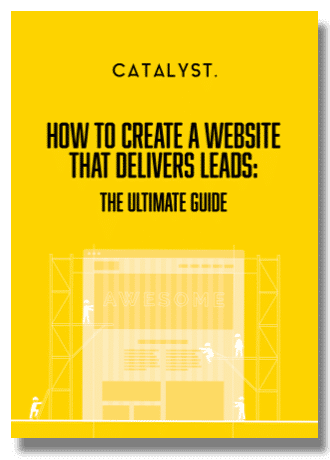Did you know that on average, nearly 80% of leads don’t convert into sales?
This means that just one out of five customers who might be interested in your products will actually end up buying from you.
Generating leads should be your top priority if you have any sort of online presence for your business, no matter whether you sell services, products or both.
Sadly, no matter what Jordan Belfort or any other sales guru may tell you, generating leads is hard.
Once you have those leads, you also need to do more than just have your sales team call them if you want to convert more into paying customers.
So, what are the most common sales and marketing mistakes when it comes to lead generation and lead conversion?
5 Reasons Why You’re Not Generating Leads
One of the reasons websites don’t generate more leads is because they are not actively focused on promoting products and services.
Some websites act more like a product catalogue when they should actually be designed and used as a marketing tool.
Website owners need to change their philosophy when it comes to generating leads and employing different types of tools and strategies to achieve their goals.
You need to direct prospects through a full sales and marketing funnel, putting some serious thought into how you’ll get more prospects onto your site in the first place and exactly how to guide them through from just visiting the site to actually enquiring and buying.
So if you’re not generating enough leads to grow your business online – or would at least like to generate more quality leads – it’s probably down to one of the following reasons.
1. Your Website Doesn’t Have Social Proof
Social proof refers to the fact that people are more likely to do something if they think it’s the done thing and everyone else is doing it.
Also known as herd mentality, this is both a business tactic and psychological principle.
Used correctly, this tactic can be used to generate more leads and increase conversion rate on our website.
Websites which have product reviews are, for example, much more likely to convert because they appear trustworthy in the eyes of customers and show that other people are genuinely using the product or service in question.
It has been discovered that around 70% of all potential customers look at reviews before buying something.
What’s more, you can actually add a stream of reviews to your site in strategic places using tools like Trustpilot’s Trust Boxes and Proof.
Good examples of social proof items include client testimonials, product reviews and endorsements.
All of the above won’t be right for your business, but the point is it’s key to
For more on this topic, read: 5 Tiny Hacks to Give You HUGE Conversion Rates Today.
2. You’re Not Giving Something For Free
We know it sounds counterintuitive to give something away free in order to generate more revenue, but these days, people are constantly on the lookout for free things that add value to their lives.
Giving something to prospects for free can prove your value to them before they purchase, getting them in the habit of coming to your business to solve their challenges.
If you have a website and want to attract more leads, try to give them something for free. A free e-book in exchange for their email address is the classic example of this.
Depending on your industry, you could also offer a free sample of a product or even a free audit of their current setup in order to get your foot in the door.
This gives others a chance to explore your products or services without making a financial commitment.
This opens the communications lines and allows you to start a relationship, giving you the chance to capture more leads and convert them into customers.
Looking for new ways to generate quality leads online? Download our free guide.
3. You Don’t Take Your Blog Seriously
While it might sound more like something for teenagers to worry about than seasoned business directors, you should never underestimate the power of a blog.
With a proper content and SEO strategy, a blog can be used to improve your website’s rankings in Google, ensuring that the thousands of people who search for your products and services every week land on your site, rather than a competitor’s.
Although generating leads with a blog can be a slow process, it’s something we’d highly recommend getting started on as soon as possible.
You can start by educating your readership on your products, services and the benefits they offer. Post one or two articles per week and pay attention to what topics visitors gravitate towards.
More importantly, when speaking directly to your customers and prospects and listen to the common questions they ask; this should act as inspiration for your blog.
Readers love to learn more about a brand through high-quality content, so you’re already doing them a favour and engaging with them in a non-salesy way.
Once your visitors become more educated about your services, they’ll trust you more and be more likely to convert into leads and customers.
Need support writing killer SEO content? Our copywriters are on hand to discuss your needs. Book a call today.
4. You Don’t Use Good Calls to Action
Your call to action (CTA) is one of the most important parts of your digital strategy.
A CTA directs the customer through your sales funnel and flags what the next step is that you want them to take.
It’s important to know how to lead your customers and tell them exactly what they should do to take the relationship to the next stage.
That’s why your CTA buttons have to be visible across your site and positioned in key points of your web pages.
Make sure that you use various colour schemes to make your CTA button as attractive and obvious as possible.
5. You Don’t Solve Problems
Any product or service in this world is structured towards solving a specific problem.
Sadly, most businesses don’t think this way and instead talk about features and benefits rather than solutions.
This can make entire sales and marketing strategies very boring to engage with and very selfish in their approach, talking more about the business than the prospect.
Ask yourself honestly: if you were a visitor to your website or prospect reading your emails, would you know why you should buy?
If the answer is no, then you need to identify the challenges you solve and talk about those more prominently in your marketing output.
Think about the benefits you can bring to your target audience and how your solution can make their lives better.
When you implement a problem-solving mentality into your communications, you’ll naturally generate more leads just by being easier to engage with.
In Conclusion
Most businesses still rely on networking, cold calls and referrals to generate their leads. While these tactics still work, there’s a host of leads that you can’t engage this way.
That’s where we come in.
Our varied team of specialists at Catalyst are experts in generating warm, sales qualified leads.
If you’d like to generate more higher quality leads, get in touch today,
Alternatively, reach out to us using the below details:
E: hello@wearecatalyst.co.uk
T: 0121 296 5275



